 W
WThe Exposição Internacional do Porto, known in English as the International Exhibition of 1865, was a world's fair held in the Portuguese city of Porto. The exhibition was housed inside the grand Palácio de Cristal, which was modelled on the synonymous Crystal Palace erected for The Great Exhibition held during 1851 in London. The building's designer was Anglo-Irish civil engineer Francis Webb Sheilds, who also engineered its construction – he had been the resident engineer for the earlier building between 1852 and 1858.
 W
WAeminium was the ancient name of the city of Coimbra, in Portugal.
 W
WJoaquim António de Aguiar was a Portuguese politician. He held several relevant political posts during the Portuguese constitutional monarchy, namely as leader of the Cartists and later of the Partido Regenerador. He was three times prime minister of Portugal: between 1841 and 1842, in 1860 and finally from 1865 to 1868, when he entered a coalition with the Partido Progressista, in what became known as the Governo de Fusão.
 W
WThe April Revolt, in the history of Portugal, was an absolutist political revolt that took place in April 1824. It succeeded the Vilafrancada (1823) and foreshadowed the Portuguese Civil War (1828–1834).
 W
WThe Battle of Arronches was an encounter between the forces of the Portuguese Empire and of the Spanish Empire in 1653, near Arronches, Alentejo. The Portuguese, significantly outnumbered, managed to outflank the Spanish forces and defeat them badly.
 W
WAudax, Ditalcus and Minurus were Turdetanian warriors who participated in the Lusitanian War. They were the supposed betrayers and assassins of the Lusitanian leader Viriathus.
 W
WBaixo Alentejo was a Portuguese province. It was abolished with the Constitution of 1976.
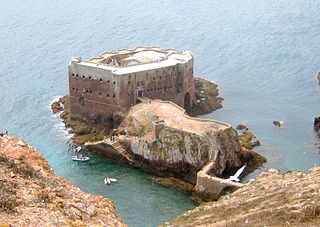 W
WThe Battle of Berlengas was fought in 1666 during the Portuguese Restoration War, between the Portuguese defenders of the Fort São João Baptista and a Spanish fleet commanded by Diego de Ibarra. The fleet, which had destroyed Portuguese fisheries, bombarded towns and cut off supplies in one month as part of its onslaught, proceeded to storm the fort on the Berlengas. The fort was destroyed and the entire garrison were captured.
 W
WThe Belém Monstrance is a significant monstrance made of gold and polychrome enamels. It is probably the most famous work by a Portuguese goldsmith, and is much-admired for its historical importance and artistic merit. It is dated 1506 and attributed to the Portuguese goldsmith and playwright Gil Vicente, on a commission by King Manuel I for the Royal Chapel, and later left in the King's will to the Jerónimos Monastery in Belém, at the time an outskirt of Lisbon, whence it derives its name.
 W
WThe Bracari or Callaeci Bracari were an ancient Celtic tribe of Gallaecia, living in the northwest of modern Portugal, in the province of Minho, between the rivers Tâmega and Cávado. After the conquest of the region beginning in 136BC, the Romans established the Augustan citadel of Bracara, modern Braga, in 20 BC.
 W
WThe Chamber of Deputies of Portugal, alternatively translatable as the House of Commons and formally styled the Chamber of the Gentlemen Deputies of the Portuguese Nation was the lower house of the Cortes Gerais, the legislature of the Kingdom of Portugal during most of the constitutional monarchy period. The Chamber of Deputies directly represented the Portuguese Nation, elected through direct suffrage of the electoral circuits corresponding to the districts of Portugal. During the First Republic, the Chamber of Deputies was remodeled after the US House of Representatives.
 W
WThe Chamber of Deputies of the Portuguese Republic, alternatively translatable as the House of Representatives, was the lower house of the Congress of the Republic, the legislature of the First Portuguese Republic. The Chamber of Deputies was elected for a three-year term and had the power to lay taxes, Initiate Constitutional Amendments and Legislation regarding the Armed Forces, debate on bills proposed by the Executive, and decide on the extension of the legislative term.
 W
WThe Chamber of Peers of Portugal, alternatively translatable as the House of Lords and formally styled the Chamber of the Most Worthy Peers of the Realm, was the upper house of the Cortes Gerais, the legislature of the Kingdom of Portugal during most of the constitutional monarchy period. Members of the Chamber were Peers of the Realm, appointed directly at the pleasure of the Portuguese monarch.
 W
WConistorgis was the main city of the Conii or Cynetes. In the Conii language it probably meant "city of the Conii". The Celtici seem to have been present there.
 W
WThe Council of Portugal, officially, the Royal and Supreme Council of Portugal, was the ruling body and a key part of the government of the Kingdom of Portugal during the Iberian Union. The council was founded in 1582 by Philip I of Portugal following the model of the Council of Castile. It provided Portugal with a large degree of autonomy from the Portuguese House of Habsburg.
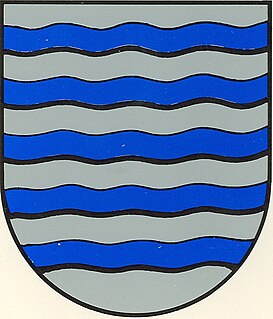 W
WCount of Alvor was a Portuguese title of nobility granted by king Peter II of Portugal on 4 February 1683, to Francisco de Távora, second son of António Luís de Távora, 2nd Count of São João da Pesqueira.
 W
WCount of Atouguia was a Portuguese title of nobility created by a royal decree, dated from 17 December 1448, by King Afonso V of Portugal, and granted to D. Álvaro Gonçalves de Ataíde.
 W
WCount of Miranda do Corvo was a Portuguese title of nobility created by a royal decree, dated from March 21, 1611, by King Philip II of Portugal, also known as Philip III of Spain, and granted to Dom Henrique de Sousa Tavares.
 W
WCount of Peniche was a Portuguese title of nobility created by a royal decree, dated from December 6, 1806, by Prince Regent John, on behalf of Queen Maria I of Portugal, and granted to Caetano José de Noronha e Albuquerque, younger son of the 3rd Marquis of Angeja and 4th Count of Vila Verde.
 W
WCount of Viana was a Portuguese title of nobility granted on February 8, 1692, by King Peter II of Portugal to D. José de Menezes, the King's master-stableman, who died without issue.
 W
WCount of Vila Nova de Portimão was a Portuguese title of nobility granted on 28 May 1504, by King Manuel I of Portugal to D. Martinho de Castelo Branco, 2nd Lord of Vila Nova de Portimão.
 W
WThe Emboscada was a palace coup of 6 October 1846, by which queen Maria II deposed the government presided over by Pedro de Sousa Holstein, 1st Duke of Palmela, that had been installed on 20 May that year as a result of the Revolution of Maria da Fonte. By thus dismissing the government of Palmela, that had only come to power 5 months earlier, and replacing it with a Cartista government presided over by João Francisco de Saldanha Oliveira e Daun, 1st Duke of Saldanha, the monarch rekindled the revolt and precipitated the civil war known as the Patuleia.
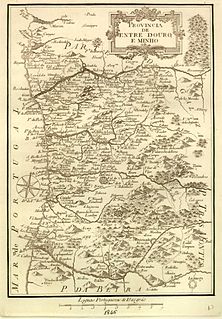 W
WEntre Douro e Minho is one of the historical provinces of Portugal which encompassed the country's northern Atlantic seaboard between the Douro and Minho rivers. Contemporaries often referred to the province as simply "Minho". It was one of six provinces Portugal was commonly divided into from the early modern period until 1936, although these provinces were not recognized as official units of government.
 W
WThe Equaesi were an ancient Celtic tribe of Gallaecia, who lived in the north of modern Portugal, between the provinces of Minho and Trás-os-Montes, near the border of modern Galicia (Spain).
 W
WVasco Fernandes Coutinho (1490–1561) was a Portuguese fidalgo and the first donatary of the Captaincy of Espírito Santo, a colonial territory in what is now Brazil.
 W
WAnselmo Braamcamp Freire was a Portuguese historian, genealogist and politician. A member of the National Constituent Assembly, he became the first president of the (Second) Portuguese Senate. While a historian, he authored a notable study of the life of Vasco da Gama. His house in Santarém is now the city's municipal library.
 W
WGogolá was a sub-region of Portuguese India, being a continental enclave within the Diu region.
 W
WThe history of the Jews in Belmonte, Portugal, reaches back over five hundred years.
 W
WThe Hymno Patriótico was considered Portugal’s first national anthem. Marcos Portugal, who had remained living in Portugal, had, in 1808, initially named the piece as ‘the Prince’s Hymn’. With this dedication, it was offered to the Prince Regent D. John and first performed for him in Brazil in 1809. The anthem was inspired by the cantata "La Speranza o sia l’Augurio Felice". The lyrics changed several times, altered by contemporary events, until settling into a more or less permanent form in 1821.
 W
WThe Kingdom of Northern Lusitania was a kingdom proposed by Napoleon in 1807 for the King of Etruria, Charles Louis, located in the North of Portugal.
 W
WLacobriga was an ancient town of Celtic origin, usually identified as the predecessor of the current city of Lagos in Portugal. The nearby Archaeological Site of Monte Molião is also known as Lacobriga.
 W
WCirilo Volkmar Machado is considered to have been the first historian of Portuguese art. He was also a Portuguese painter, sculptor and architect.
 W
WCount of Oeiras was a Portuguese title of nobility created by a royal decree, dated from July 15, 1759, by King Joseph I of Portugal, and granted to Sebastião José de Carvalho e Melo, head of the Portuguese government.
 W
WThe Marriage Treaty or the Anglo-Portuguese Treaty was a treaty of alliance agreed between the Kingdom of England and Portugal concluded on June 23, 1661. It led to the marriage of Charles II of England and Catherine of Braganza, the daughter of John IV of Portugal. The pact renewed the traditional Anglo-Portuguese Alliance between the countries. It was a marriage of state, common in the era.
 W
WMenir da Cabeça do Rochedo
 W
WNabia was the goddess of rivers and water in Gallaecian and Lusitanian mythology, in the territory of modern Galicia (Spain), Asturias (Spain) and Portugal.
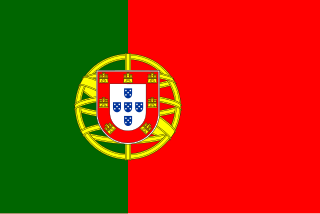 W
WThe National Salvation Junta was a group of military officers designated to maintain the government of Portugal in April 1974 after the Carnation Revolution had overthrown the Estado Novo dictatorial regime. This junta assumed power following a communiqué of its president, António de Spínola, at 1:30 a.m. on 26 April 1974. The National Salvation Junta was the de jure governing body of Portugal following the Carnation Revolution.
 W
WIn Latin poetry Oestreminis was a name given to the territory of what is today modern Portugal and Galicia, comparable to Finis terrae, the "end of the earth" from a Mediterranean perspective. Its inhabitants were named Oestrimni from their location.
 W
WThe Paesuri or Paesures were an ancient pre-Roman Tribe of Lusitania, akin to the Lusitani, to whom they were a dependent tribe.
 W
WThe Patuleia, Guerra da Patuleia, or Little Civil War was a civil war in Portugal, so called to distinguish it from the 'great' civil war between Dom Pedro and Dom Miguel that ended in 1834. The Patuleia occurred after the Revolution of Maria da Fonte, and was closely associated with her. It was caused by the nomination, as a result of the palace coup of 6 October 1846, known as the "Emboscada", to set up a clearly Cartista government presided over by marshal João Oliveira e Daun, Duque de Saldanha.
 W
WThe Portuguese Gold Coast was a Portuguese colony on the West African Gold Coast on the Gulf of Guinea.
 W
WThe Battle of Praia Bay was fought by the coast of Terceira Island on August 11, 1829, between Portuguese liberals and a Miguelite fleet as part of the Portuguese civil war.
 W
WThe Roman ruins of Santo Andre de Almoçageme is a Portuguese archaeological site located in the rural civil parish of Colares, in the municipality of Sintra. It includes a group of structures with typological, stylistic or historic value, whose structural elements are worthy of preservation.
 W
WD. Frei Inácio de São Caetano, O.C.D., was a Portuguese scholar, theologian, and church leader. He was appointed the first bishop of Penafiel when the diocese was erected by Pope Clement XIV in 1770; when the diocese was suppressed 8 years later, he was promoted to Titular Archbishop of Thessalonica.
 W
WScallabis was the Roman name of Santarém, Portugal.
 W
WThe Siege of Lisbon was a siege of the city of Lisbon from 29 May to 3 September 1384, between the Portuguese defenders of the city led by John I of Portugal and the Castillian army led by King John I of Castile. The siege ended in a disaster for Castile. A plague outbreak together with the constant attacks by Portuguese forces led by Nuno Álvares Pereira caused huge casualties among the Castilian ranks, who were forced to retreat four months after the start of the siege.
 W
WThe Taifa of Mértola was a medieval Moorish taifa that existed in what is now southeastern Portugal. It existed during three distinct periods: from 1033 to 1044, from 1144 to 1145, and from 1146 to 1151. From 1044 until 1091 it was under the forcible control of the Taifa of Seville, by Abbad II al-Mu'tadid. Its short-lived history ended in 1151, when it was finally conquered by the Almohad Caliphate.
 W
WThe Taifa of Santa Maria do Algarve was a medieval taifa Moorish kingdom or emirate located in what is now southern Portugal, that existed from 1018 to 1051. From 1051 until 1091, it was under the forcible control of Seville via Abbad II al-Mu'tadid. Known as the Banu Harun, their descendants remained as Qadis of the city until its reconquest by Portugal in 1249, the last of whom being Aloandro Ben Bekar.
 W
WDom Teodósio I of Braganza was the 5th Duke of Braganza, among other titles. He is known for ceding the title of Duke of Guimarães to Infante Duarte of Aviz, alongside some of the wealth and properties of the House of Braganza.
 W
WTongoenabiagus was the god of the Fonte do Ídolo, a 1st-century shrine in Braga with an inscribed fountain dedicated both to Tongoenabiagus and the goddess Nabia. His name may derive from the Celtic root *tenge(o)- and so he may have been associated with the swearing of oaths.
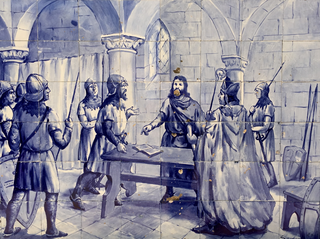 W
WThe Treaty of Zamora recognized Portuguese independence from the Kingdom of León. Based on the terms of the accord, King Alfonso VII of León recognized the Kingdom of Portugal in the presence of his cousin King Afonso I of Portugal, witnessed by the papal representative, Cardinal Guido de Vico, at the Cathedral of Zamora. Both kings promised durable peace between their kingdoms. By this treaty Afonso I of Portugal also recognized the suzerainty of the Pope.
 W
WViriatos, named after the Lusitanian leader Viriathus, was the generic name given to Portuguese volunteers who fought with the Nationalists in the Spanish Civil War. In the first weeks of the war, the Portuguese Army tried to form a Viriatos Legion to aid the Nationalist insurgents in Spain. The Legion was disbanded before any recruitment drive could take place after pro-Republican incidents in Portugal had convinced the government that direct intervention on the side of the Nationalists could cause further unrest.
 W
WYoung Communist League was the youth wing of the Portuguese Communist Party. UJC was founded in 1975.
 W
WThe Zoelae were an ancient Celtic tribe of Gallaecia, living in the north of modern Portugal, in the province of Trás-os-Montes, between the mountains of Serra da Nogueira and the mountains of Mogadouro.